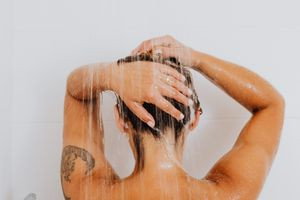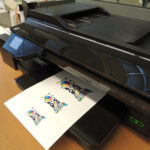So, you’ve just gotten inked and you’re probably wondering, Can You Get A Tattoo Wet The Next Day? The answer is yes, but with precautions. This comprehensive guide from tattooat.com will provide you with all the essential information on safely getting your new tattoo wet, ensuring it heals properly and stays vibrant. We’ll cover everything from showering to swimming, offering expert advice to protect your investment in body art, avoid infection, and maintain the clarity of your tattoo.
1. Understanding Tattoo Aftercare Basics
Before diving into the specifics of getting a tattoo wet, it’s crucial to understand the fundamentals of tattoo aftercare. A new tattoo is essentially an open wound, and proper care is essential to prevent infection and ensure optimal healing.
1.1. The First 24 Hours: A Critical Period
The first 24 hours after getting a tattoo are the most critical. During this time, the tattoo is most vulnerable to infection. It’s important to keep the tattoo covered with the bandage applied by your artist for the recommended time, usually a few hours.
1.2. Importance of Cleanliness
Keeping your tattoo clean is paramount. However, cleaning doesn’t mean soaking. Gentle washing with antibacterial soap is necessary, but prolonged exposure to water should be avoided.
2. Can You Shower With a New Tattoo?
Yes, you can shower with a new tattoo, but the key is to do it carefully and follow specific guidelines to protect your skin art.
2.1. Timing Your First Shower
It’s generally safe to shower 24 hours after getting your tattoo. This allows the initial healing process to begin and reduces the risk of infection.
2.2. Protective Measures
- Saniderm Bandage: If your tattoo artist used a Saniderm bandage, you’re in luck! This waterproof bandage is designed to protect your tattoo while showering.
- Gentle Washing: Even with Saniderm, avoid direct, high-pressure water on the tattoo. Use a mild, fragrance-free antibacterial soap to gently cleanse the area.
- Lukewarm Water: Hot water can open your pores and cause ink to leach out. Stick to lukewarm water to minimize fading and irritation.
- Pat Dry: After showering, gently pat the tattoo dry with a clean, soft towel. Avoid rubbing, as this can irritate the skin and disrupt the healing process.
 Fresh tattoo covered with Saniderm, showcasing waterproof protection
Fresh tattoo covered with Saniderm, showcasing waterproof protection
2.3. What If I Don’t Have Saniderm?
If your tattoo is covered with a traditional bandage or plastic wrap, remove it after the recommended time (usually a few hours). Gently wash the tattoo with antibacterial soap and lukewarm water, then pat it dry.
2.4. Showers vs. Baths
Showers are preferable to baths when you have a new tattoo. Soaking in a tub can expose the tattoo to bacteria and prolong its exposure to water, increasing the risk of infection.
3. How to Properly Wash Your Tattoo
Washing your tattoo is a crucial part of the aftercare process. Here’s a step-by-step guide:
3.1. Gather Your Supplies
- Mild, fragrance-free antibacterial soap
- Clean, soft towel
- Lukewarm water
3.2. The Washing Process
- Wash Your Hands: Before touching your tattoo, wash your hands thoroughly with soap and water.
- Gently Lather: Apply a small amount of antibacterial soap to your fingertips and gently lather.
- Clean the Tattoo: Use your fingertips to gently clean the tattoo in a circular motion. Avoid scrubbing or using abrasive materials like loofahs.
- Rinse Thoroughly: Rinse the tattoo with lukewarm water, ensuring all soap is removed.
- Pat Dry: Gently pat the tattoo dry with a clean, soft towel.
- Apply Aftercare Ointment: Once the tattoo is dry, apply a thin layer of aftercare ointment, such as Aquaphor or a tattoo-specific balm.
3.3. Frequency of Washing
Wash your tattoo 2-3 times a day during the healing process, or as directed by your tattoo artist.
4. The Dos and Don’ts of Getting a Tattoo Wet
To ensure your tattoo heals properly, it’s important to follow these dos and don’ts:
4.1. Dos
- Use Saniderm: If possible, use a Saniderm bandage to protect your tattoo while showering.
- Shower Briefly: Keep your showers short to minimize water exposure.
- Use Lukewarm Water: Avoid hot water, which can damage the tattoo.
- Pat Dry Gently: Use a clean, soft towel to pat the tattoo dry.
- Follow Artist’s Instructions: Always adhere to the aftercare instructions provided by your tattoo artist.
4.2. Don’ts
- Soak the Tattoo: Avoid baths, swimming pools, and prolonged submersion in water.
- Use Abrasive Materials: Don’t use loofahs, washcloths, or other abrasive materials to clean the tattoo.
- Apply Harsh Soaps: Avoid soaps with fragrances, alcohol, or harsh chemicals.
- Rub the Tattoo: Don’t rub the tattoo with a towel, as this can cause irritation and disrupt healing.
- Re-bandage Immediately: After washing, allow the tattoo to air dry before applying aftercare ointment.
5. Can You Go Swimming With a New Tattoo?
No, you should not go swimming with a new tattoo. Swimming pools, oceans, and lakes are breeding grounds for bacteria, which can cause serious infections.
5.1. Risks of Swimming
- Bacterial Infections: Water in swimming pools and natural bodies of water can contain harmful bacteria that can infect your tattoo.
- Chlorine and Salt Water: Chlorine in swimming pools and salt water in oceans can irritate the skin and cause the tattoo to fade.
- Prolonged Submersion: Soaking the tattoo in water can disrupt the healing process and increase the risk of infection.
5.2. When Can You Swim Again?
Wait at least 3-4 weeks, or until your tattoo is fully healed, before swimming. Even then, it’s a good idea to apply a waterproof bandage or tattoo balm to protect it.
 Woman enjoying a swim with a fully healed tattoo on her arm
Woman enjoying a swim with a fully healed tattoo on her arm
6. What Happens If Your Tattoo Gets Too Wet?
If your tattoo gets excessively wet, don’t panic. Gently pat it dry with a clean, soft towel and allow it to air dry completely. Apply a thin layer of aftercare ointment to keep it moisturized.
6.1. Signs of Infection
Be vigilant for signs of infection, such as:
- Excessive redness
- Swelling
- Pain
- Pus or drainage
- Fever
If you notice any of these symptoms, consult a doctor or your tattoo artist immediately.
7. Choosing the Right Tattoo Artist and Studio
The aftercare process starts with choosing a reputable tattoo artist and studio. A skilled artist will provide detailed aftercare instructions and ensure a safe, hygienic tattooing process.
7.1. Research and Reviews
Read reviews and ask for recommendations from friends or online communities. Look for studios with a clean, professional environment.
7.2. Consultations
Schedule a consultation with the artist to discuss your design and aftercare expectations. A good artist will be knowledgeable and willing to answer your questions.
7.3. Hygiene Standards
Ensure the studio follows strict hygiene standards, including the use of sterile equipment and disposable needles.
8. Tattoo Aftercare Products
Choosing the right aftercare products can significantly impact the healing process.
8.1. Antibacterial Soap
Opt for a mild, fragrance-free antibacterial soap like Dr. Bronner’s Baby Unscented or Cetaphil Gentle Skin Cleanser.
8.2. Aftercare Ointments
Popular aftercare ointments include Aquaphor, Tattoo Goo, and Hustle Butter Deluxe. These products help keep the tattoo moisturized and promote healing.
8.3. Saniderm Bandages
If your artist recommends Saniderm, follow their instructions carefully. This waterproof bandage can protect your tattoo and speed up the healing process.
9. Common Tattoo Healing Issues and Solutions
Even with the best care, some common issues may arise during the tattoo healing process.
9.1. Itching
Itching is a common side effect of tattoo healing. Avoid scratching, as this can damage the skin and introduce bacteria. Instead, gently pat the tattoo or apply a cold compress.
9.2. Peeling
Peeling is another normal part of the healing process. Allow the skin to peel naturally and avoid picking at it.
9.3. Scabbing
Scabbing can occur if the tattoo is not kept properly moisturized. Apply a thin layer of aftercare ointment to keep the scabs soft and prevent them from cracking.
10. Long-Term Tattoo Care
Once your tattoo is fully healed, it’s important to continue caring for it to keep it looking its best.
10.1. Sun Protection
Sun exposure can cause tattoos to fade over time. Apply a high-SPF sunscreen to protect your tattoo when you’re outdoors.
10.2. Moisturizing
Keep your tattoo moisturized with a fragrance-free lotion to prevent the skin from drying out.
10.3. Hydration
Drinking plenty of water can help keep your skin hydrated and healthy, which is beneficial for your tattoo.
11. Addressing Tattoo Myths
There are many myths surrounding tattoo aftercare. Let’s debunk some of the most common ones.
11.1. Myth: Tattoos Need to “Breathe”
While it’s important to allow the tattoo to air dry after washing, it doesn’t need to “breathe” in the traditional sense. Keeping it moisturized is more important.
11.2. Myth: You Should Re-bandage Your Tattoo
Unless specifically instructed by your tattoo artist, re-bandaging is generally not necessary and can trap moisture, increasing the risk of infection.
11.3. Myth: All Ointments Are Safe for Tattoos
Avoid using petroleum-based products like Vaseline, as they can clog pores and hinder healing. Stick to recommended aftercare ointments.
12. The Role of Tattooat.com in Your Tattoo Journey
At tattooat.com, we are dedicated to providing you with the most reliable information and inspiration for your tattoo journey.
12.1. Design Ideas
Explore our extensive library of tattoo designs to find the perfect inspiration for your next piece of body art.
12.2. Artist Directory
Connect with talented tattoo artists in the USA and find the perfect match for your style and preferences. Located at 1825 SW Broadway, Portland, OR 97201, United States, and reachable by phone at +1 (503) 725-3000, we can provide recommendations.
12.3. Expert Advice
Access our comprehensive guides and articles on tattoo aftercare, trends, and history to make informed decisions about your tattoos.
13. Understanding the Science Behind Tattoo Healing
Delving into the science behind tattoo healing can help you appreciate the importance of proper aftercare.
13.1. The Body’s Response to Tattoos
When you get a tattoo, the needle punctures the skin, creating tiny wounds. The body’s immune system responds by sending white blood cells to the area to fight off infection and initiate the healing process.
13.2. The Role of Collagen
Collagen, a protein that provides structure to the skin, plays a crucial role in tattoo healing. Proper aftercare promotes collagen production, which helps to repair the damaged tissue and seal the ink in place.
13.3. Factors Affecting Healing Time
Several factors can affect tattoo healing time, including:
- Size and Location: Larger tattoos and those in areas with more friction (like the hands or feet) may take longer to heal.
- Overall Health: A healthy immune system is essential for efficient healing.
- Aftercare Practices: Following proper aftercare instructions can significantly speed up the healing process.
14. Showcasing Tattoo Styles and Trends in the USA
The USA is a hub for diverse tattoo styles and trends. Staying informed about these can help you choose a design that resonates with your personal style.
14.1. Popular Tattoo Styles
- Traditional American: Bold outlines and classic motifs.
- Neo-Traditional: A modern take on traditional styles with vibrant colors and intricate details.
- Realism: Highly detailed and lifelike designs.
- Watercolor: Soft, flowing designs that mimic the look of watercolor paintings.
- Geometric: Precise and symmetrical patterns.
14.2. Up-and-Coming Trends
- Fine Line Tattoos: Delicate and minimalist designs.
- Blackwork Tattoos: Bold and graphic designs using only black ink.
- Botanical Tattoos: Intricate depictions of plants and flowers.
14.3. Tattoo Culture in Portland
Portland, Oregon, is known for its vibrant tattoo culture. The city is home to many talented artists and studios that push the boundaries of tattoo art. According to research from Portland State University’s Art Department, in July 2023, Portland has the highest concentration of tattoo artists per capita in the United States.
15. Addressing Concerns About Pain and Long-Term Effects
Many people have concerns about the pain of getting a tattoo and its long-term effects.
15.1. Pain Management
Pain tolerance varies from person to person. However, there are several ways to manage pain during the tattooing process, including:
- Numbing Creams: Topical numbing creams can help reduce pain.
- Breaks: Don’t hesitate to ask your artist for breaks if you need them.
- Breathing Techniques: Deep breathing can help you relax and manage pain.
15.2. Long-Term Considerations
- Fading: Tattoos may fade over time, especially if they’re not protected from the sun.
- Stretching: Weight gain or loss can cause tattoos to stretch or distort.
- Removal: If you regret your tattoo, laser tattoo removal is an option, but it can be expensive and painful.
16. Expert Tips from Tattoo Artists
We’ve gathered expert tips from professional tattoo artists to help you make the most of your tattoo experience.
16.1. Communication is Key
Communicate openly with your artist about your design ideas, pain tolerance, and aftercare concerns.
16.2. Trust the Process
Trust your artist’s expertise and follow their recommendations.
16.3. Be Patient
Tattoo healing takes time, so be patient and consistent with your aftercare routine.
17. Staying Updated on Tattoo Events and Conventions in the USA
Attending tattoo events and conventions can be a great way to meet artists, see new designs, and learn about the latest trends.
17.1. Notable Tattoo Conventions
- Hell City Tattoo Festival: Columbus, Ohio.
- Philadelphia Tattoo Arts Convention: Philadelphia, Pennsylvania.
- Golden State Tattoo Expo: Pasadena, California.
17.2. Benefits of Attending
- Inspiration: See a wide variety of tattoo styles and designs.
- Networking: Connect with artists and other tattoo enthusiasts.
- Education: Attend seminars and workshops on tattoo techniques and aftercare.
18. Tattoo FAQs
Here are some frequently asked questions about getting a tattoo wet:
18.1. Can I Use Vaseline on My New Tattoo?
No, Vaseline is not recommended for new tattoos. It can clog pores and hinder healing.
18.2. How Long Should I Keep My Tattoo Bandaged?
Follow your artist’s instructions, but generally, remove the bandage after a few hours or as directed.
18.3. What If My Tattoo Is Still Weepy After a Few Days?
A little weeping is normal, but if it persists, consult your artist or a doctor.
18.4. Can I Exercise After Getting a Tattoo?
Avoid strenuous exercise for at least a week, as sweat can irritate the tattoo.
18.5. What Should I Wear to My Tattoo Appointment?
Wear loose, comfortable clothing that won’t rub against the tattoo.
18.6. Can I Drink Alcohol After Getting a Tattoo?
Avoid alcohol for at least 48 hours, as it can thin your blood and interfere with healing.
18.7. Is It Okay to Shave the Area Around My New Tattoo?
Wait until the tattoo is fully healed (about 3-4 weeks) before shaving.
18.8. How Can I Prevent My Tattoo From Fading?
Protect your tattoo from the sun and keep it moisturized.
18.9. What Do I Do If My Tattoo Starts to Peel Excessively?
Resist the urge to pick at the peeling skin. Apply a thin layer of aftercare ointment to keep it moisturized.
18.10. How Do I Choose the Right Tattoo Artist?
Research their style, read reviews, and schedule a consultation to ensure they’re a good fit for you.
19. Conclusion
So, can you get a tattoo wet the next day? Yes, but with care and attention to aftercare guidelines. At tattooat.com, we’re here to guide you through every step of your tattoo journey, from finding the perfect design to ensuring proper healing. Remember, a well-cared-for tattoo is a vibrant, long-lasting piece of art.
20. Call to Action
Ready to explore the world of tattoos? Visit tattooat.com today to discover stunning designs, connect with talented artists, and access expert advice on tattoo aftercare. Find inspiration, resources, and everything you need to make your tattoo dreams a reality. Start your tattoo adventure with us now! Contact us at Address: 1825 SW Broadway, Portland, OR 97201, United States. Phone: +1 (503) 725-3000. Website: tattooat.com.
